| Portuguese VISLSentence AnalysisEdutainmentCorporaDictionariesMachine Translation |
Eckhard Bick
PORTUGUESE SYNTAX
6. Group forms and group level constituent function
Groups (or phrases) are here defined as syntactic constituents that are not clauses, and consist of more than one word. In order not to be clauses, none of the group node's immediate constituents must be a predicator or a complementizer (subordinator). Every group features 1 head (H) and one or more dependents (D), which may be either modifiers (Dmod) or arguments (Darg). In this text, we will denote all kinds of group level dependents with the umbrella term adjects.
As on the clause level, arguments are valency bound. Modifiers are on the group level what adjuncts are on the clause level - they are "free" constituents without valency slots. The word class inventory of a group's head and dependents defines the group's form category. Accordingly, 4 main types of groups can be distinguished:
| group type | typical heads | typical adjects (modifier or argument dependents) |
| np noun phrase | noun
proper noun "substantival" pronoun |
adjective
article "adjectival" pronoun |
| ap adpositional phrase | adjective
adverb "adjectival" pronoun |
adverb |
| pp prepositional phrase | preposition | noun
"substantival" pronoun icl fcl |
| vp verb phrase | verb
(main verb [semantically] or 1. auxiliary [dependency]) |
verb
(auxiliaries [semantically] or 2./following verbs [dependency]) preposition or the conjunction que |
Groups can be classified in yet another way, as hypotactic (endocentric) , katatactic (exocentric) and paratactic. Hypotactic groups (np- or ap-type groups) can semantically be substituted by their head, which is not true of katatactic groups (pp-type). Some grammarians even base their definition of head on a group being hypotactic according to this substitution rule - thus, a pp would not have a head at all, since none of its constituents can stand for the whole group. Verb groups (vp) are the most special of all: they are hypotactic in the sense that the main verb can semantically replace the whole vp, but in dependency and valency terms, it is the main verb (or a subordinated AUX<:icl), that is an argument of the auxiliary, not the other way around. A paratactic group consists of two co-ordinated constituents, usually of the same form type, that share a common function label. Parataxis will be discussed in detail in chapter 9 (Co-ordination).
| symbol | category |
|
|
| np | np
propp pronp |
noun phrase
sintagma nominal nominalsyntagme |
A velha avó dormia na rede. (np) Vou fazê-lo eu mesmo. (pronp) O seu nome era Mário Moreno dos Santos. (propp) |
| ap | adjp
advp detp |
adpositional
phrase
sintagma adposicional adpositionssyntagme |
Foi um presidente um pouco iconoclasta. (adjp) Nesta saia, parece mais jovem do que as amigas. (adjp) Costuma falar muito devagar. (advp) Ainda hoje vivem de caça e pesca. (advp) Era muito mais vinho do que imaginava. (detp) |
| vp | verb phrase
sintagma verbal verbalsyntagme |
Vem de lhes propor um acordo. Temos que lhe dar mais dinheiro. |
|
| pp | prepositional
phrase
sintagma preposicional præpositionssyntagme |
Gostou do que viu. Pedro da Silva Mudamos para São Paulo. |
|
Noun phrases (np)
The prototypical np is headed by a noun, and allows a choice of adnominal adjects (group-level dependents), typically pre- and post-modifiers. Heavy (i.e. long or complex) modifiers and adnominal arguments appear only to the right of the head.
Typical premodifiers are:
determiner pronouns (adjectival pronouns): todos estes livros
numerals: 7
nanos
prepositional phrases (pp) o jatinho do presidente
relative subclauses:
o computador que comprou
Compare: um grande homem (great) - um homem grande (big)
Only certain adjectives tend to occur in premodifier position. In some cases, grammarians even disagree on the word class of a prenominal modifier, because it looks like an adjective (and inflects like one), but functions like a (determiner) pronoun or numeral. Consider the following cases:
a primeira noite (numeral or adjective)
a última unção (adjective or numeral)
umas/algumas/várias propostas (adjective or pronoun)
a mesma cor, outra cor, diferentes cores (adjective or pronoun)
Determiner pronouns in postmodifier position are rare, comprising possessives and - with a change in meaning - todo. próprio and mesmo occur postnominally with independent "substantival" pronouns, that do not allow premodifiers:
responsabilidade sua (cp. a sua mãe - *a mãe sua)
a casa toda ([whole], cp. toda casa [every])
ele mesmo ([himself], cp. a mesma cor [same])
ela própria (cp. o próprio presidente, o próprio Cardoso)
"Adjectival" modifiers
need not be individual words, but can become complex forms themselves (adjective
phrases), as discussed in chapter 6.2:
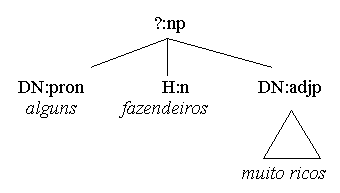
Some nouns (titles, professions, family membership terms etc.) may have noun or proper noun (name) modifiers, and complex names may themselves be described as np's with a proper noun head and a chain of one or more proper noun modifiers to the right, yielding "left leaning" (read: head to the left) analyses for name expressions.

Name modifiers can be "isolated" from their head noun by other (adjectival) modifiers:

Not all names are simple chains of proper nouns - some integrate recognizable adjectives, numerals or prepositional phrases that one would want to mark as such:

In the last example, "name-hood" first arises on the np-level, since neither of the two constituents of the modifier np qualifies as a proper noun (prop).
One way of marking what's part of a name and what isn't, in terms of constituents, is by means of constituent bracketing. Thus, instead of marking a and Grande in a Grande São Paulo as "sister"-modifiers on the same level, one would first bracket Grande onto são Paulo, forming a complex head for the article a:
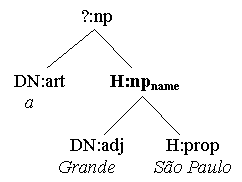

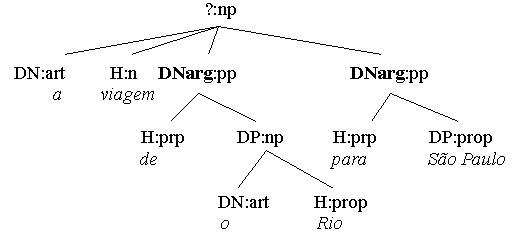

afinidade a
confiança em
cumplicidade com
discussão sobre
escolha entre
lei contra
respeito por
semelhança com
temor de
páginas 8-12
século vinte
no dia 5
de julho 1998

Apposition adjects are identifiers and help define or denote the referent of the np in question, while adject predicatives are descriptive and act much like adjunct predicatives (fC) on the clause level. As a matter of fact, ambiguity as to whether a non-argument predicative attaches at clause or group level is not at all rare. Thus, predicatives left of the subject (a), or comma-separated predicatives to the right of the predicator (c) are clearly fC, while the same predicative "feels" more like a DN-constituent if found directly to the right of the subject (b).
(a) Contente com a vida, o hipopótamo dormia na água.
(b) O hipopótamo, contente com a vida, dormia na água.
(c) O hipopótamo dormia na água, contente com a vida.
One argument in favour of the DNc analysis for (b) is the fact that the constituent can be replaced by a DN relative clause (which cannot be moved to other positions in the sentence): O hipopótamo, que era contente com a vida, ... Note that it is the comma-separation between np-head and the DN dependent, that makes a DNc. For que-clauses, the distinction between DN (without comma) and DNc (with comma) equals the semantic distintion between restrictive (necessary) and parenthetical (non-necessary) relative clauses.
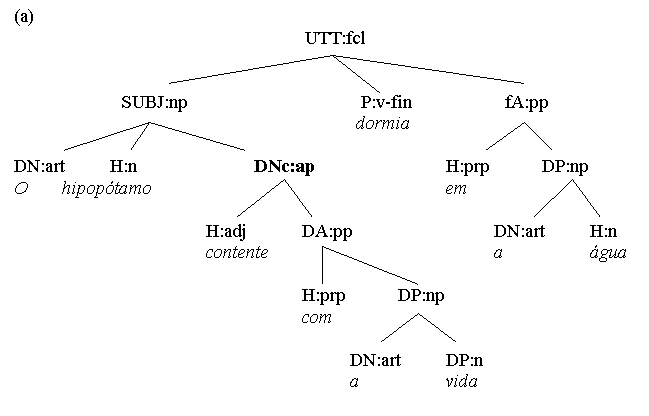
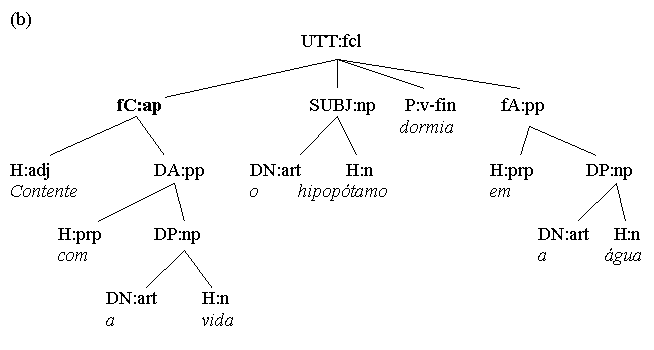
Finally, all np's can be modified by certain operator adverbs denoting negation (nem) , set inclusion (também, só) or avaliation (até) :
até ele, nem Pedro, só isso, dinheiro demais
However, in the presence of other modifiers, it becomes clear, that these "operators" don't mingle with other modifiers and it does not seem entirely satisfying to treat them as constituent-sisters of ordinary modifiers. Rather, they modify the whole np, as could be expressed by adding one bracket or tree level to our syntactic analysis, with the "inner np" as the complex head of a kind of "meta-np" (np') :
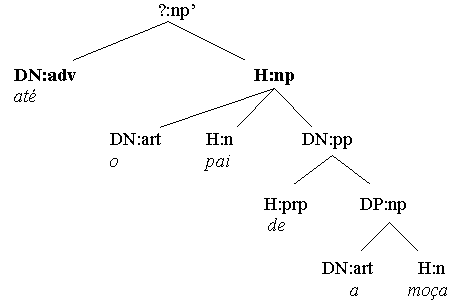
Further discussion:
One of the functions of the operator adverbs mentioned above is that
of focus marker (cp. chapter 11 on focus-constructions). Focus marker dependents
(Dfoc) put their head into focus, and they can be attached to heads of
any form (x), - words, groups, clauses and compound units, generating
a meta-constituent of the same form (x'). By using the Dfoc tag in these
cases, we do not have to uphold the awkward distinction between DN, DA,
DP and so on, for what appears only one type of function (Dfoc).
As a positive side effect, most independent ("substantival") pronoun
groups (até ele, ele mesmo) become "meta-words", - which is
more in line with one's view on independent pronouns as "unmodifiable"
(cp. 6.4).
In order to avoid conflict with VISL's general definition of words
and groups, we will, however, refrain from using terms like pron, n, adj etc. for focused individual words. Thus, ordinary group form categories
(or, at most, np?, ap? etc.) will be used in these cases, too.
Adpositional phrases
(ap)
The term adpositional
phrase will here be used to lump together adjective phrases (adjp) ,
adverb phrases (advp) and (adjectival) determiner pronoun phrases
(detp) , all of which allow the same prototypical type of modifier
- intensifier/quantifier adverbs, - and not much else. Thus, all three
types of ap's can be premodified by the adverb muito .
Determiner phrases
are very rare, and restricted to quantifier modifiers, but adjp's and advp's
do allow a few other - non-quantifying - modifiers:
manner adverbs: academicamente
verboso
time operators: já
morto
Like np's, ap's allow
certain logical, set or modal operators as premodifiers:
Most modifier variation,
however, is seen with "adjectival participles" , i.e. participles
used as modifiers in noun phrases, not as part of a verb chain, because
participles - even as modifiers - retain their parent verb's affinity for
adjuncts and even arguments (the function of which could be attached to
the DA-tag in small letters).
Due to the rich clause-like
structure in participle ap's, one obvious alternative analysis is that
of non-finite clause (icl) in stead of ap (cp. chapter 7.2.3.1):
Adverbs with a valency
pattern are rare:
In the last example
inclusive translates as including. There is another reading, equivalent
to até (even), where inclusive is an operator adverb and functions
as a (focus) dependent rather than as a head (cp. further discussion
in chapter 6.1):
Some adverbs form "complex
prepositions" (antes de, depois de) or "complex conjunctions"
(antes que, depois que), that could be analysed as adverbs heading ap's with pp- or fcl-arguments, respectively. Another case are the comparative
adverbs mais, menos, tão, tanto that valency-govern comparandum
arguments (DAcom) in constructions like menos formosa do que
uma hipopótama (cp.
chapter 9).
Prepositional phrases
(pp)
A prepositional phrase
is not hypotactic (or endocentric), like np's and ap's. Rather, it is katatactic
(or exocentric), as none of its constituents can syntactically stand for
the whole group. However, valency-wise it is the preposition that links
the group to a head on the next syntactic level. Thus, it is a specific
preposition that is governed and "asked for" when a verb, noun or adjective
allows pp-arguments. Therefore, in dependency grammar, the preposition
counts as head (H) of the pp, with the rest of the pp rolling as the preposition's
[dependent] argument (DParg or, simply, DP) .
The argument position
can be filled by almost any type of word class, group or clause, but most
typically by np's and those word classes that qualify as np-heads, including
infinitives and infinitive clauses.
passeava com a
mãe (np)
discutiram sobre
você (pron)
preparou-se para
a palestra que ia dar o outro dia (np)
gostava de ler
na cama (icl)
andava com medo de
magoá-la (icl)
However, also adverbs
(até hoje, para aqui) and finite clauses (sem que o soubesse) do occur as DP's.
pp's in general do
not allow ordinary modifiers like np's and ap's, but only the kind of "operator
adverbs" already mentioned in the last chapter, and - in a few cases
- premodifying intensifiers. Both only occur as preadjects, and a simple
analysis would treat them as "sisters" of the preposition's postadject
argument.
Like with np's and
ap's, one could argue against this "flat" analysis that ainda and nem
are not modifiers of a preposition at all, but rather focus markers for
the whole pp, introducing an additional bracket/level and making the kernel
pp the complex head of a new form, a kind of "meta-pp" (pp'):
Functionally, pp's
can be prepositional objects (Opiv), argument adverbials (A), adjunct adverbials
(fA), or - on the group level - arguments or modifiers in np's (DNarg,
DNmod) or ap's (DAarg, DAmod).
Mandaram-no para
a Índia. (Ao)
Sem mais nada,
venderam a velha casa, sede da família durante séculos. (fA)
Lhe deu uma coroa
com oitenta jóias. (DNmod)
Era grande de
corpo e coração. (DAmod)
Era legendária
a sua capacidade de tornar em ouro o que tocava. (DNarg)
Escolheu uma senha
quase impossível de lembrar. (DAarg)
Está com
febre. (Cs)
Mário Goncalves,
de Pernambuco, mantém que até tocou num extraterrestre.
(DNc)
With regard to subordinating
function, the prepositions com and sem are a special case. They can
create a kind of clausal nexus without verbs, conjunctions or relatives.
Consider:
(foram fotografados)
com todo mundo já seminu
sem ela para ajudar
(não conseguiu nada mais)
A group analysis seems
more conservative, since it doesn't assign the preposition any unusual
function and is structurally close to the even more conservative reading
where the DNc tag becomes an ordinary attributive DNmod. Also, clause functions
like S and Cs usually presuppose some verbal valency (a copula verb, for
instance), -which just isn't there. On the other hand, clause functions
like S and Cs are exactly what is needed to build a predicating nexus without
a predicator.
There is a certain
confusion as to the status of prepositions as a form or a function category,
and one could argue that even the prototypical function of a preposition
(as "pp-header" governing an np) is really one of subordinator ("SUBpp").
This "functional" view of the category preposition explains why many
grammars treat conjunctions (que) or or relative adverbs (como)
as "prepositions" if they head a comparandum with an np body:
pior que isso, bela como a tia.





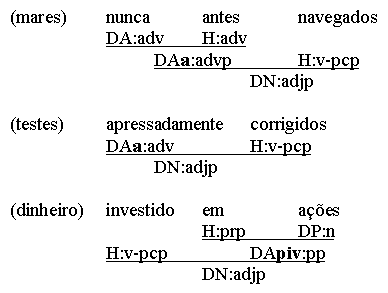
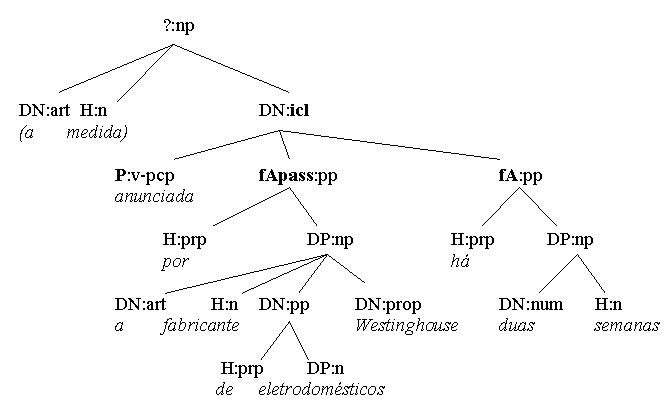



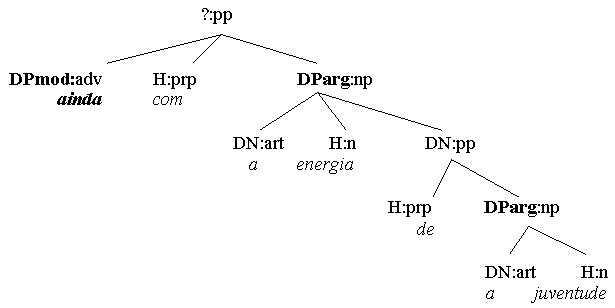
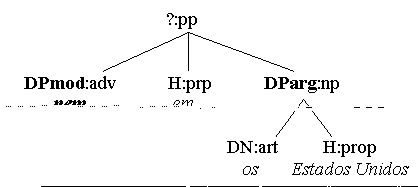
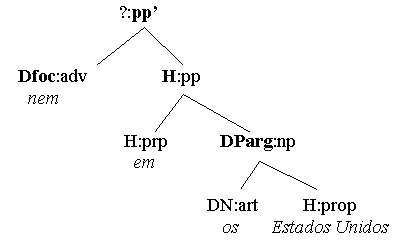
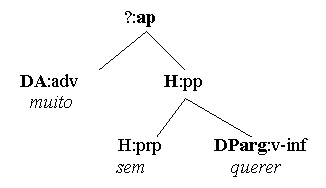
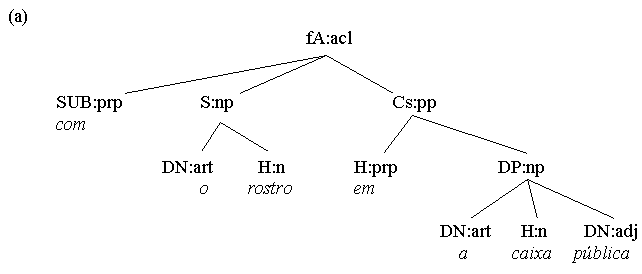
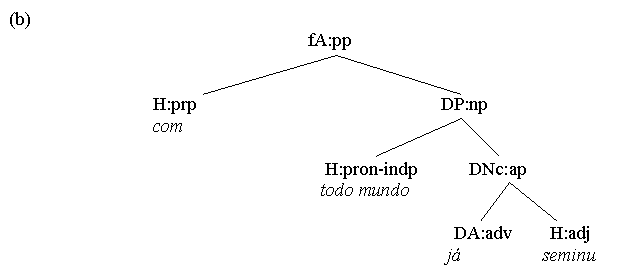
Pronoun phrases
Pronoun phrases can be divided into determiner phrases (detp) and independent pronoun phrases (pronp). Detp's are a subclass of ap's and the few determiner pronouns - possessives and quantifiers - that allow dependents, take modifiers of the intensifier/quantifier type, like adjp's and advp's:
Agora, a casa era inteiramente
sua.
Pronp's are treated as a subclass of np's, and have the same functional register as other np's, but they are heavily restricted as to their choice of modifiers, allowing only "operator class adverbs", and - for personal pronouns - mesmo and próprio:
até você
nem isso
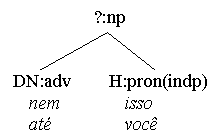

Further discussion:
One could be tempted to argue that the pronouns in these examples
aren't really modified, but focused (as discussed in chapter
11 and 6.1), with the resulting constituent being a meta-word rather than
a group:
We will not here pursue
this line of thought any further, since the concept of multi-word "meta-words"
is in conflict with the VISL-system's general definition of words and
groups.
Article groups,
finally, are happily non-existent in Portuguese.
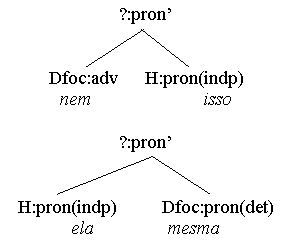
symbol
category
H
- D
head <->
dependent
núcleo <-> dependente
hoved <-> dependent
sem
dinheiro
devagar
demais
D
DN
DNmod
DNarg
>N, N<adnominal
adject
adjeto adnominal
adnominaladjekt
(H: noun or pronoun)
a
(1) mulher do
amigo (2) (modifiers)
um
tanto (modifier)
cacique Jerônimo
(modifier)
Manoel Neto
(1) da Silva (2) (modifiers)
a proposta de
lhe ajudar (argument)
combinaram a venda da
casa. (argument)
predisposição para
diabete (argument)
DNapp
APP(adnominal)
apposition
aposição (do substantivo)
[epíteto de identidade]
(nominal-) apposition
DNc
N<PREDpredicative
adject
adjeto predicativo
[epíteto predicativo]
preædikativadjekt
com a mão na
bolsa
DA
DAmod
DAarg
>A, A<adverbial
adject
adjeto adverbial
adverbialadjekt
(H: adjective, adverb or determiner)
devagar demais
(modifier)
rico em
ouro (argument)
receoso de
lhe ter ofendido (argument)
DAcom
KOMP<argument
of comparative
complemento comparativo
komparativkomplement
DP
DParg
DPmod
P<, >Pargument
of preposition
argumento de preposição
præpositionsargument
[styrelse]
quase
sem dinheiro (modifier)